Seat Leon SC 2014 MEDIA SYSTEM 2.2
Manufacturer: SEAT, Model Year: 2014, Model line: Leon SC, Model: Seat Leon SC 2014Pages: 114, PDF Size: 2.47 MB
Page 11 of 114
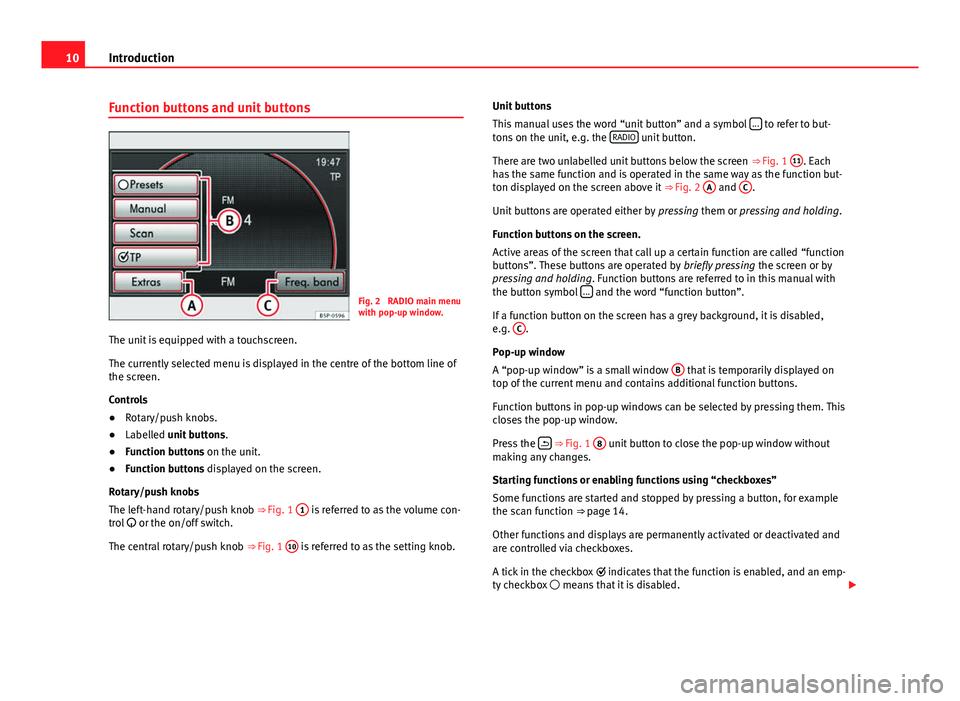
10Introduction
Function buttons and unit buttons
Fig. 2 RADIO main menu
with pop-up window.
The unit is equipped with a touchscreen.
The currently selected menu is displayed in the centre of the bottom line of
the screen.
Controls
● Rotary/push knobs.
● Labelled unit buttons .
● Function buttons on the unit.
● Function buttons displayed on the screen.
Rotary/push knobs
The left-hand rotary/push knob ⇒ Fig. 1 1
is referred to as the volume con-
trol or the on/off switch.
The central rotary/push knob ⇒ Fig. 1 10
is referred to as the setting knob. Unit buttons
This manual uses the word “unit button” and a symbol
...
to refer to but-
tons on the unit, e.g. the RADIO unit button.
There are two unlabelled unit buttons below the screen ⇒ Fig. 1 11
. Each
has the same function and is operated in the same way as the function but-
ton displayed on the screen above it ⇒ Fig. 2 A
and C.
Unit buttons are operated either by pressing them or pressing and holding.
Function buttons on the screen.
Active areas of the screen that call up a certain function are called “function
buttons”. These buttons are operated by briefly pressing the screen or by
pressing and holding. Function buttons are referred to in this manual with
the button symbol ...
and the word “function button”.
If a function button on the screen has a grey background, it is disabled,
e.g. C
.
Pop-up window
A “pop-up window” is a small window B
that is temporarily displayed on
top of the current menu and contains additional function buttons.
Function buttons in pop-up windows can be selected by pressing them. This
closes the pop-up window.
Press the
⇒ Fig. 1 8 unit button to close the pop-up window without
making any changes.
Starting functions or enabling functions using “checkboxes”
Some functions are started and stopped by pressing a button, for example
the scan function ⇒ page 14.
Other functions and displays are permanently activated or deactivated and
are controlled via checkboxes.
A tick in the checkbox indicates that the function is enabled, and an emp-
ty checkbox means that it is disabled.
Page 12 of 114
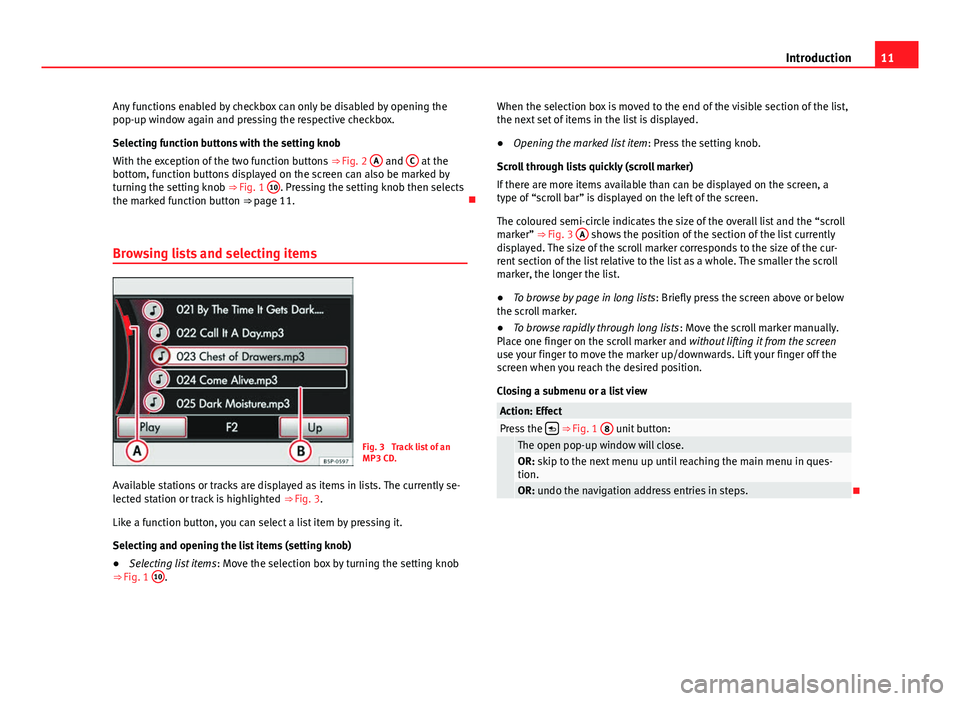
11
Introduction
Any functions enabled by checkbox can only be disabled by opening the
pop-up window again and pressing the respective checkbox.
Selecting function buttons with the setting knob
With the exception of the two function buttons ⇒ Fig. 2 A
and C at the
bottom, function buttons displayed on the screen can also be marked by
turning the setting knob ⇒ Fig. 1 10
. Pressing the setting knob then selects
the marked function button ⇒ page 11.
Browsing lists and selecting items
Fig. 3 Track list of an
MP3 CD.
Available stations or tracks are displayed as items in lists. The currently se-
lected station or track is highlighted ⇒ Fig. 3.
Like a function button, you can select a list item by pressing it.
Selecting and opening the list items (setting knob)
● Selecting list items : Move the selection box by turning the setting knob
⇒ Fig. 1 10
. When the selection box is moved to the end of the visible section of the list,
the next set of items in the list is displayed.
● Opening the marked list item : Press the setting knob.
Scroll through lists quickly (scroll marker)
If there are more items available than can be displayed on the screen, a
type of “scroll bar” is displayed on the left of the screen.
The coloured semi-circle indicates the size of the overall list and the “scroll
marker” ⇒ Fig. 3 A
shows the position of the section of the list currently
displayed. The size of the scroll marker corresponds to the size of the cur-
rent section of the list relative to the list as a whole. The smaller the scroll
marker, the longer the list.
● To browse by page in long lists : Briefly press the screen above or below
the scroll marker.
● To browse rapidly through long lists : Move the scroll marker manually.
Place one finger on the scroll marker and without lifting it from the screen
use your finger to move the marker up/downwards. Lift your finger off the
screen when you reach the desired position.
Closing a submenu or a list view
Action: EffectPress the ⇒ Fig. 1
8 unit button:
The open pop-up window will close.OR: skip to the next menu up until reaching the main menu in ques-
tion.
OR: undo the navigation address entries in steps.
Page 13 of 114
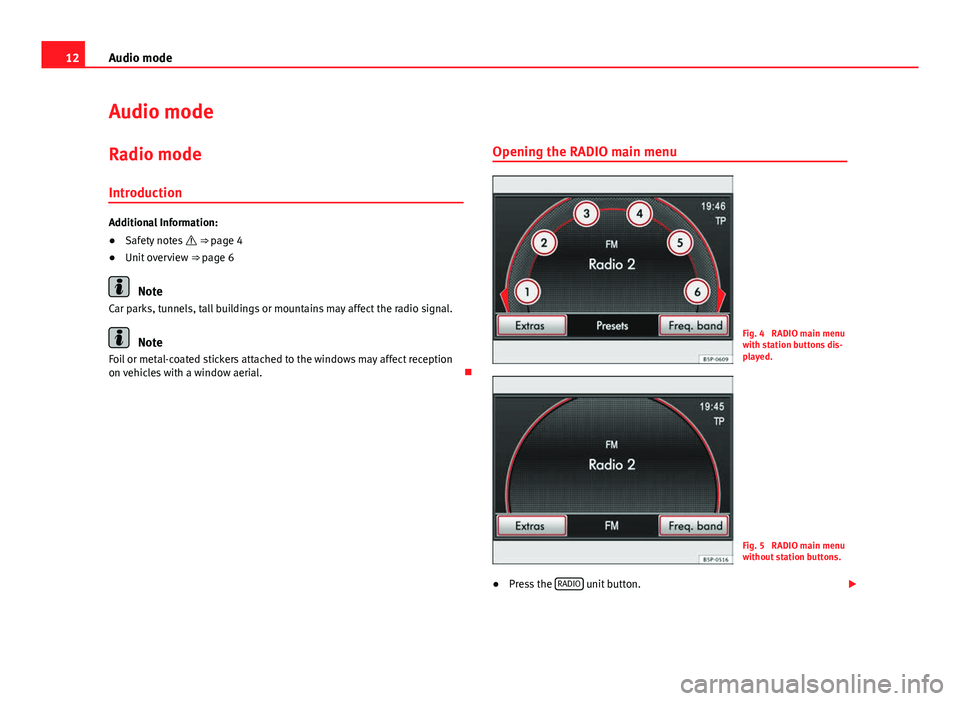
12Audio mode
Audio mode
Radio mode Introduction
Additional Information:
● Safety notes ⇒ page 4
● Unit overview ⇒ page 6
Note
Car parks, tunnels, tall buildings or mountains may affect the radio signal.
Note
Foil or metal-coated stickers attached to the windows may affect reception
on vehicles with a window aerial. Opening the RADIO main menuFig. 4 RADIO main menu
with station buttons dis-
played.
Fig. 5 RADIO main menu
without station buttons.
● Press the RADIO
unit button.
Page 14 of 114

13
Audio mode
The station you are currently listening to is shown in the middle of the
screen.
The “station buttons” in the main RADIO menu ⇒ Fig. 4 can be displayed or
hidden ⇒ page 16.
Displaying station name (RDS)
The RDS (Radio Data System) is not compatible with all units and is not
available everywhere or on all radio stations.
If RDS is available and reception is good enough, the station name is dis-
played (in Fig. 5: Radio 2).
In addition, the RDS allows for automatic tracking of stations, radio texts or
traffic programmes ⇒ page 19.
Changing frequency band
Fig. 6 RADIO main
menu: Band function but-
ton.
The currently selected frequency band is indicated above the station display
and in the bottom line of the screen. Changing frequency band
● In the RADIO main menu, press the RADIO
unit button.
● OR: Press the Band function button and select the range of frequencies
by pressing the corresponding button ⇒ Fig. 6.
Changing radio station or selecting radio stations from the
FM station list
Fig. 7 Station list: the
current station is high-
lighted.
Change radio station by pressing the arrow buttons
or .
● Briefly press an arrow button or .
Depending on the arrow button settings ⇒ page 17, it is only possible to
change between stored stations (display: in
⇒ Fig. 13).
If the TP function is on (display: TP), it is only possible to change to stations
that accept this function ⇒ page 19.
Page 15 of 114

14Audio mode
Opening the FM station list
The FM station list shows all the FM stations with good reception. You can
select a specific station from the FM station list.
● Switch to the FM frequency band ⇒ page 13.
● Press the Band
function button and press the FM/List function button in
the pop-up window ⇒ Fig. 6.
● Alternatively: if the display station buttons off is ⇒ page 16, by turn-
ing the setting knob ⇒ Fig. 1 10
it is possible to change directly to the sta-
tion list.
The FM station list view closes after one minute of inactivity. The FM station
list is updated automatically.
No station list is available for the AM frequency band.
Selecting stations from the FM station list and saving them
● Open the FM station list.
● Mark a station by turning the setting knob and press the setting knob to
select the marked station ⇒ page 8.
● Alternatively: Drag the scroll marker to browse the list and select the de-
sired station by pressing it on the screen ⇒ page 8.
● After selecting a station button, press the Store
function button
⇒ Fig. 7
to store the marked station ⇒ page 16.
● To close the FM station list press the
unit button.Scan function (Scan)
Fig. 8 RADIO main
menu: Extras function
button.
Fig. 9 RADIO main menu
during scan.
When the scan function is running, all available stations on the current fre-
quency band are played in sequence for approximately 5 seconds each.
Page 16 of 114
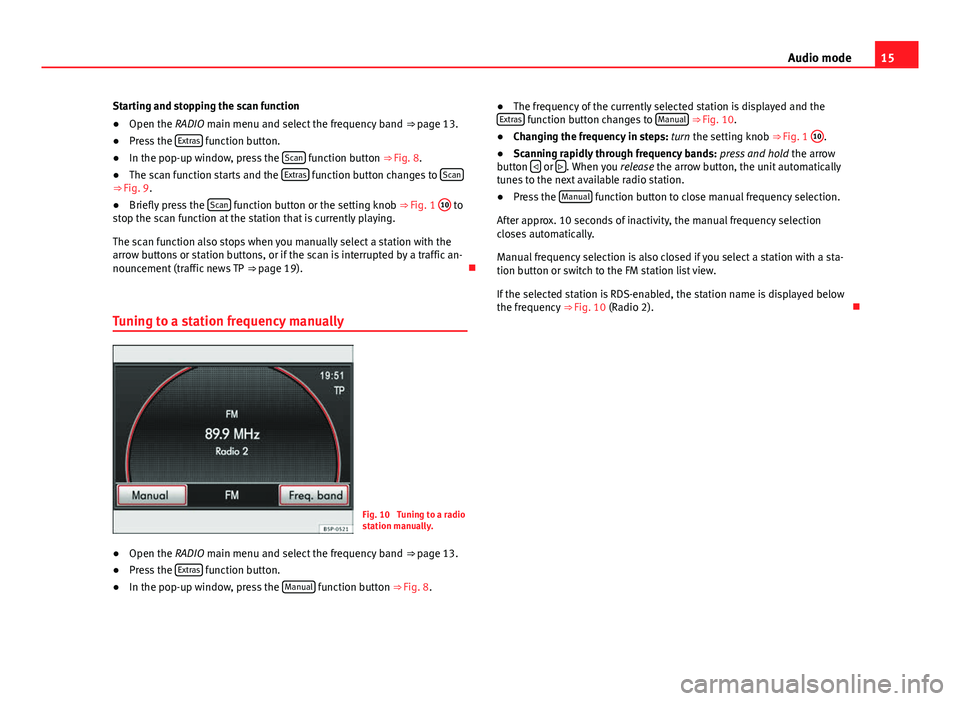
15
Audio mode
Starting and stopping the scan function
● Open the RADIO main menu and select the frequency band ⇒ page 13.
● Press the Extras
function button.
● In the pop-up window, press the Scan function button ⇒ Fig. 8.
● The scan function starts and the Extras function button changes to Scan⇒ Fig. 9.
●
Briefly press the Scan function button or the setting knob ⇒
Fig. 1 10 to
stop the scan function at the station that is currently playing.
The scan function also stops when you manually select a station with the
arrow buttons or station buttons, or if the scan is interrupted by a traffic an-
nouncement (traffic news TP ⇒ page 19).
Tuning to a station frequency manually
Fig. 10 Tuning to a radio
station manually.
● Open the RADIO main menu and select the frequency band
⇒ page 13.
● Press the Extras
function button.
● In the pop-up window, press the Manual function button
⇒ Fig. 8. ●
The frequency of the currently selected station is displayed and the
Extras
function button changes to Manual ⇒ Fig. 10.
● Changing the frequency in steps: turn the setting knob ⇒ Fig. 1 10.
● Scanning rapidly through frequency bands: press and hold the arrow
button
or . When you
release the arrow button, the unit automatically
tunes to the next available radio station.
● Press the Manual
function button to close manual frequency selection.
After approx. 10 seconds of inactivity, the manual frequency selection
closes automatically.
Manual frequency selection is also closed if you select a station with a sta-
tion button or switch to the FM station list view.
If the selected station is RDS-enabled, the station name is displayed below
the frequency ⇒ Fig. 10 (Radio 2).
Page 17 of 114
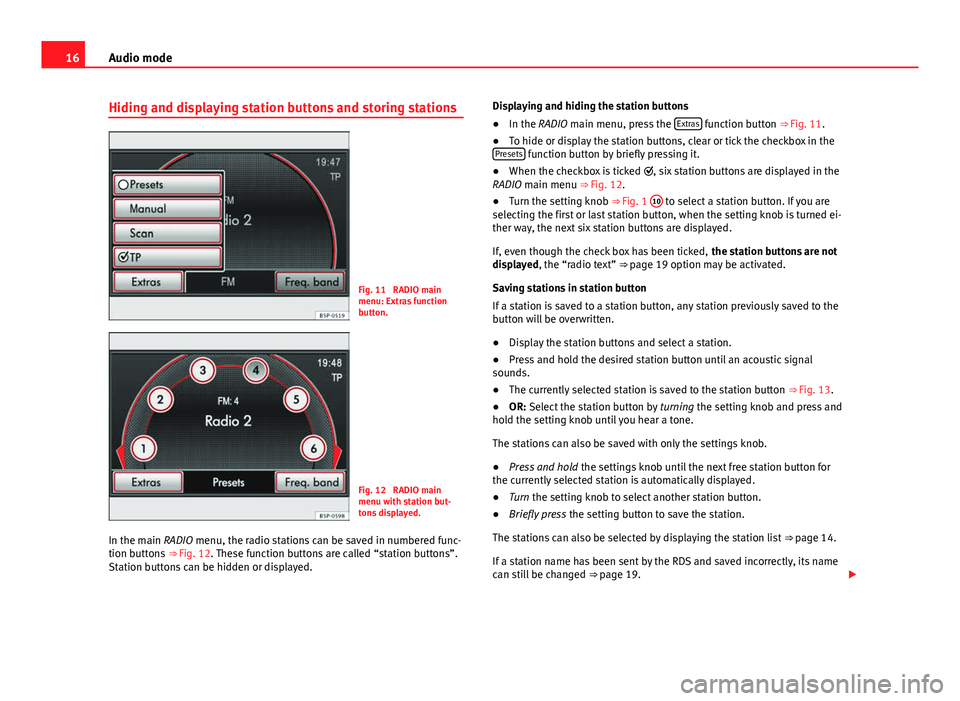
16Audio mode
Hiding and displaying station buttons and storing stations
Fig. 11 RADIO main
menu: Extras function
button.
Fig. 12 RADIO main
menu with station but-
tons displayed.
In the main RADIO menu, the radio stations can be saved in numbered func-
tion buttons ⇒ Fig. 12. These function buttons are called “station buttons”.
Station buttons can be hidden or displayed. Displaying and hiding the station buttons
●
In the RADIO main menu, press the Extras
function button ⇒
Fig. 11.
● To hide or display the station buttons, clear or tick the checkbox in the
Presets
function button by briefly pressing it.
● When the checkbox is ticked , six station buttons are displayed in the
RADIO main menu ⇒ Fig. 12.
● Turn the setting knob ⇒ Fig. 1 10
to select a station button. If you are
selecting the first or last station button, when the setting knob is turned ei-
ther way, the next six station buttons are displayed.
If, even though the check box has been ticked, the station buttons are not
displayed, the “radio text” ⇒ page 19 option may be activated.
Saving stations in station button
If a station is saved to a station button, any station previously saved to the
button will be overwritten.
● Display the station buttons and select a station.
● Press and hold the desired station button until an acoustic signal
sounds.
● The currently selected station is saved to the station button ⇒ Fig. 13.
● OR: Select the station button by turning the setting knob and press and
hold the setting knob until you hear a tone.
The stations can also be saved with only the settings knob.
● Press and hold the settings knob until the next free station button for
the currently selected station is automatically displayed.
● Turn the setting knob to select another station button.
● Briefly press the setting button to save the station.
The stations can also be selected by displaying the station list ⇒ page 14.
If a station name has been sent by the RDS and saved incorrectly, its name
can still be changed ⇒ page 19.
Page 18 of 114
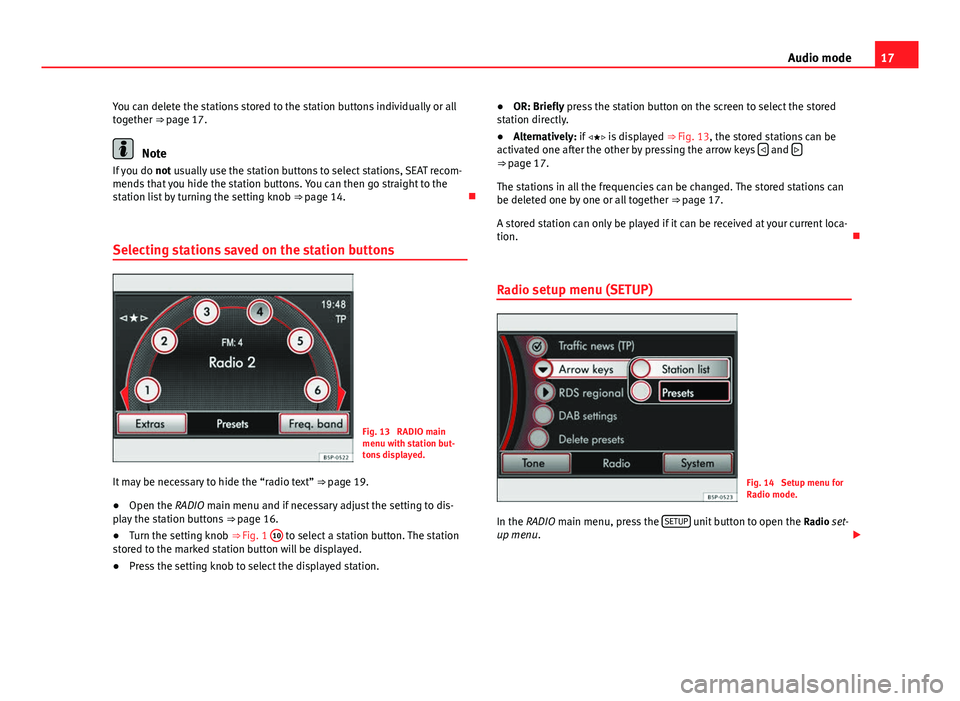
17
Audio mode
You can delete the stations stored to the station buttons individually or all
together ⇒ page 17.
Note
If you do not usually use the station buttons to select stations, SEAT recom-
mends that you hide the station buttons. You can then go straight to the
station list by turning the setting knob ⇒ page 14.
Selecting stations saved on the station buttons
Fig. 13 RADIO main
menu with station but-
tons displayed.
It may be necessary to hide the “radio text” ⇒ page 19.
● Open the RADIO main menu and if necessary adjust the setting to dis-
play the station buttons ⇒ page 16.
● Turn the setting knob ⇒ Fig. 1 10
to select a station button. The station
stored to the marked station button will be displayed.
● Press the setting knob to select the displayed station. ●
OR: Briefly press the station button on the screen to select the stored
station directly.
● Alternatively: if is displayed ⇒ Fig. 13, the stored stations can be
activated one after the other by pressing the arrow keys
and ⇒
page 17.
The stations in all the frequencies can be changed. The stored stations can
be deleted one by one or all together ⇒ page 17.
A stored station can only be played if it can be received at your current loca-
tion.
Radio setup menu (SETUP)
Fig. 14 Setup menu for
Radio mode.
In the RADIO main menu, press the SETUP
unit button to open the
Radio set-
up menu.
Page 19 of 114
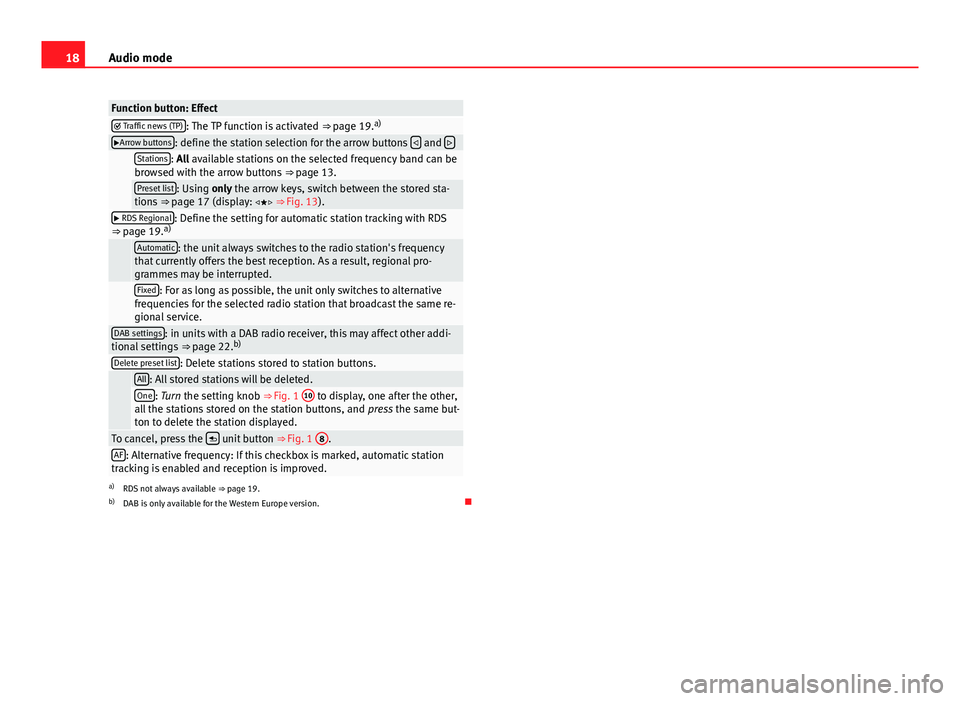
18Audio mode
Function button: Effect Traffic news (TP): The TP function is activated ⇒ page 19. a)Arrow buttons: define the station selection for the arrow buttons
and
Stations: All available stations on the selected frequency band can be
browsed with the arrow buttons ⇒ page 13.
Preset list: Using only the arrow keys, switch between the stored sta-
tions ⇒ page 17 (display: ⇒ Fig. 13).
RDS Regional: Define the setting for automatic station tracking with RDS
⇒ page 19. a)
Automatic: the unit always switches to the radio station's frequency
that currently offers the best reception. As a result, regional pro-
grammes may be interrupted.
Fixed: For as long as possible, the unit only switches to alternative
frequencies for the selected radio station that broadcast the same re-
gional service.
DAB settings: in units with a DAB radio receiver, this may affect other addi-
tional settings ⇒ page 22.b)
Delete preset list: Delete stations stored to station buttons.
All: All stored stations will be deleted.One: Turn the setting knob ⇒
Fig. 1 10 to display, one after the other,
all the stations stored on the station buttons, and press the same but-
ton to delete the station displayed.
To cancel, press the unit button
⇒ Fig. 1 8.AF: Alternative frequency: If this checkbox is marked, automatic station
tracking is enabled and reception is improved.
a) RDS not always available ⇒ page 19.
b) DAB is only available for the Western Europe version.
Page 20 of 114
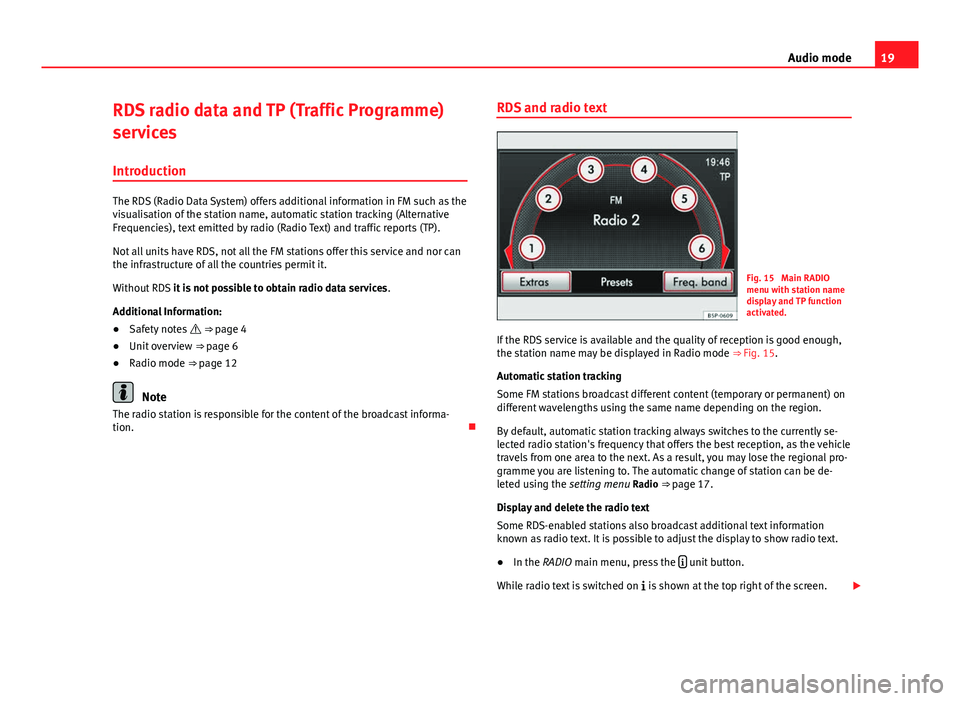
19
Audio mode
RDS radio data and TP (Traffic Programme)
services
Introduction
The RDS (Radio Data System) offers additional information in FM such as the
visualisation of the station name, automatic station tracking (Alternative
Frequencies), text emitted by radio (Radio Text) and traffic reports (TP).
Not all units have RDS, not all the FM stations offer this service and nor can
the infrastructure of all the countries permit it.
Without RDS it is not possible to obtain radio data services .
Additional Information:
● Safety notes ⇒ page 4
● Unit overview ⇒ page 6
● Radio mode ⇒ page 12
Note
The radio station is responsible for the content of the broadcast informa-
tion. RDS and radio text
Fig. 15 Main RADIO
menu with station name
display and TP function
activated.
If the RDS service is available and the quality of reception is good enough,
the station name may be displayed in Radio mode ⇒ Fig. 15.
Automatic station tracking
Some FM stations broadcast different content (temporary or permanent) on
different wavelengths using the same name depending on the region.
By default, automatic station tracking always switches to the currently se-
lected radio station's frequency that offers the best reception, as the vehicle
travels from one area to the next. As a result, you may lose the regional pro-
gramme you are listening to. The automatic change of station can be de-
leted using the setting menu Radio ⇒ page 17.
Display and delete the radio text
Some RDS-enabled stations also broadcast additional text information
known as radio text. It is possible to adjust the display to show radio text.
● In the RADIO main menu, press the
unit button.
While radio text is switched on is shown at the top right of the screen.